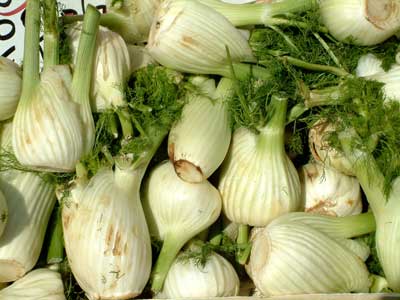Is an herb, spice, and vegetable that imparts a sweet and salty flavor, tasting both of dill and anise. The plant and its fruits/seeds are edible and it is used both fresh and cooked in European cuisines, in Russia, Iran, Israel, Pakistan, Afghanistan, India, and China, as well as in cuisines along the Mediterranean. Fennel grows in dry situations in an open, leggy habit from a tight, white cluster of ribbed, segmented stalks rising from a bulb, or in the case of wild fennel-a pseudo-bulb, from which segments grow small, tubular stems, umbels of tiny pale yellow flowers which turn to silvery-brown spindle-shaped seeds, and fern-like delicate leaves that when brushed release the refreshing volatile oil of fennel.
A member of the Umbellifereae/Apiaceae family, fennel is related to parsley, carrots, dill, caraway and coriander, has its place in both savory and sweet preparations, and can be used to substitute for or in conjunction with any of these herbs, spices, and vegetables to create a more nuanced flavor profile. All parts of the plant are edible and the leaves, for instance, like dill, pair very well with fish. In Poland and Italy, the vegetable is served sautéed in butter or olive oil, and in Sicily, the leaves flavor patties. In southern France, fennel is used extensively. Fennel lends its distinctive flavor to Italian sausage. In India, the leaves and smaller stems are eaten as greens either alone or mixed with other greens. In Greece, spinach is often flavored with the addition of fennel greens. In Israel, the stalks and bulb are served as a salad mixed with lemon and olive oil. The fruits, most potent in flavor when green, are used in Germany sprinkled on salad. Fennel’s sweetness is employed by coating the seeds/fruits with colored sugar and serving them from shallow dishes after feasts in India as a mukhwas, and in China, fennel is one of the spices in Chinese Five Spice.
Along the Mediterranean, and now, around the world in similar habitats, fennel will grow abundantly and seeds freely. In the ancient vineyards of Greece where fennel could grow alongside the main crop, the plant became twined with the God of fertility and wine, Dionysus and legend stated that knowledge, a gift of the gods to humankind was carried in a stalk of fennel in the form of a burning coal. The ancient Greek name for fennel is marathron, and in modern Greek- maratho for which the famous Battle of Marathon was named, the field upon which the battle was fought, being thick with fennel. Pheidippides, the messenger who carried the news of the Persian invasion to Sparta, was bestowed the gift of fennel so esteemed was fennel.
Long prized for its medicinal properties in both ancient Mediterranean and Ayurveda medicine, fennel aids in digestion and is widely used in tonics, tinctures and teas, and in bitters and aperitifs. It is the base of the Italian liqueur, Finochietto, is used in Absinthe, Gin, Chartreuse, and a host of other liqueurs and digestives. Steeped in tea the fruit/seeds can be made into a rinse used to reduce inflammation in the eyes. Furthermore, in addition to necessary dietary minerals and fiber, fennel provides a significant amount of protein, 19 % of the recommended daily amount of a 2000 calorie per day diet, and 345 calories per 100 gram serving size.
